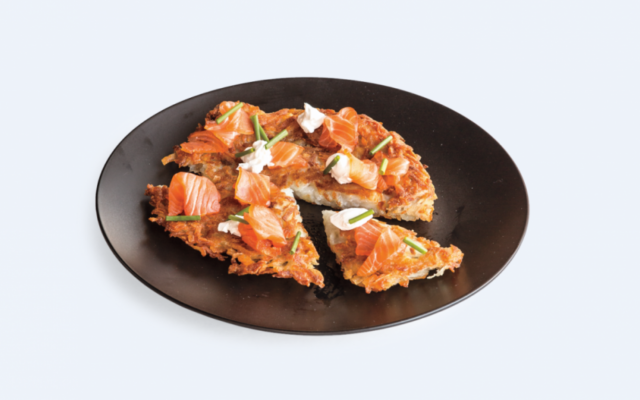A Cure for Everyday Latkes
By Michael Solomonov
This recipe for Latke With Gravlax is reprinted with permission from “Zahav: A World of Israeli Cooking” by Philadelphia chef Michael Solomonov and his business partner, Steven Cook. The lavish 368-page cookbook from publisher Houghton Mifflin Harcourt is available for $35.
It seems weird to admit that I had to work at a northern Italian restaurant to learn how to make great latkes (sorry, Mom). The trick is to use pure potato. There is more than enough starch in the potatoes to bind the latkes without using egg or flour (which make them less crispy and more dense). Potatoes can handle much more salt than seems reasonable, so make sure to taste your mixture (or fry off a small test latke) before you cook up a bland batch. Starchy things like to stick to the pan, so let the latkes cook undisturbed for a few minutes and the crust will set up and release on its own. A cast iron pan is ideal; but if you’re scared, a nonstick skillet is foolproof. I make one big latke here, but you can make many small ones, too.

Chef Michael Solomonov says he learned to make great latkes from an Italian restaurant, not his mother.
Pairing cured salmon with latkes is almost a cliché, but for good reason. Gravlax is elegant and super simple to make. The hardest part is actually slicing it into thin ribbons. I’ve found that freezing it for just 15 minutes makes the slicing much easier. Use a long sharp knife held at a very shallow angle to the surface of the gravlax and draw the knife through it from heel to tip. Placing the flat open palm of your other hand on the surface of the fish will ensure a thin, even slice.
This recipe serves six to eight people.
Gravlax
¼ cup kosher salt
2 tablespoons brown sugar
1 cup chopped fresh dill
1 pound center-cut salmon fillet, skin and pin bones removed
Combine the salt, sugar, and dill in a small bowl. Lay a large sheet of plastic wrap in a baking dish and sprinkle half the salt-sugar mixture down the center. Put the salmon on top of the salt-sugar mixture and cover with the rest of the salt-sugar mixture. Wrap the salmon tightly in the plastic wrap and refrigerate for 48 hours to cure, turning the fish over a few times. Rinse the excess salt-sugar mixture off the salmon and thinly slice to serve. Refrigerated, gravlax will keep for a week.
Latke
2 Russet potatoes, peeled and shredded (about 3½ cups)
1½ teaspoons kosher salt
Canola oil for frying
Sour cream for serving
Minced fresh chives for serving
Toss the potatoes with the salt and wring them out in a clean towel to remove excess water. Put ¼ inch oil in a large skillet. Spoon the potatoes into the cold oil in the pan in a single layer and flatten with the back of a spatula. Turn the heat to medium and cook the latke undisturbed until a deep golden crust forms on the bottom, about 15 minutes, pressing occasionally with the spatula. Flip the latke onto a plate and add more oil to the skillet. Slide the latke back into the hot skillet, uncooked side down. Cook on the second side until deep golden brown, about 8 more minutes. Slice the latke into wedges, top with gravlax slices, sour cream, and chives, and serve.
(Latke photo by Michael Persico)




comments